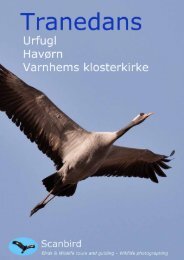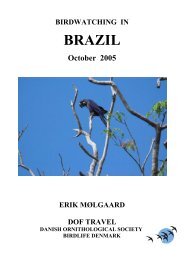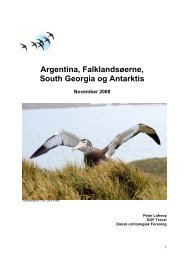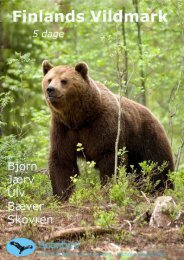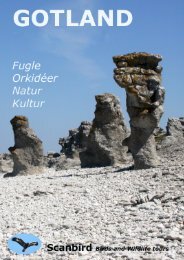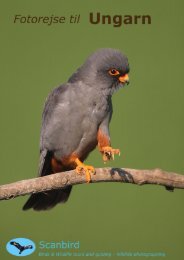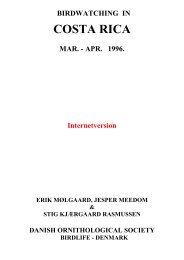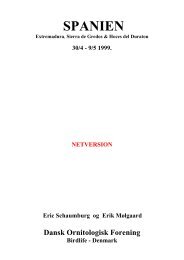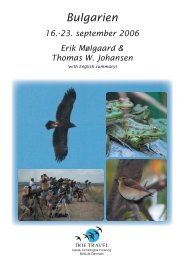Birding Southern Sweden (large PDF file (5 MB) - Tåkerns Fältstation
Birding Southern Sweden (large PDF file (5 MB) - Tåkerns Fältstation
Birding Southern Sweden (large PDF file (5 MB) - Tåkerns Fältstation
You also want an ePaper? Increase the reach of your titles
YUMPU automatically turns print PDFs into web optimized ePapers that Google loves.
Tåkern<br />
– the huge bird lake<br />
The Tåkern bird lake lies in the Östergötland cultivated flatlands<br />
immediately east of the famous rock Omberg and the <strong>large</strong><br />
lake Vättern. Tåkern is one of Europe’s most important breeding<br />
and resting places for many species. About 270 species have<br />
been seen here and about 120 species breed. The lake and its<br />
near surroundings have been established as a nature reserve (54<br />
km 2 ), and it is also a Ramsar-area. Tåkern is really just a hollow<br />
in the landscape – ca 44 km 2 big, but only 0.8m deep. It is<br />
surrounded by impressive reedbeds. Altogether it is north<br />
Europe’s <strong>large</strong>st reedbed (1500ha), which means that reedbed<br />
birds have a substantial presence. There are bird-rich shore<br />
meadows around the lake, about 450ha, and marshy or waterlogged<br />
shore woods (about 560ha). The shore meadows are kept<br />
open thanks to economic support for animal grazing.<br />
Tåkern is attractive for a visit during the breeding and migration<br />
seasons. The best times to visit the lake are May/June and<br />
September/October. There are four visiting areas at the lake (see<br />
map) – Glänås, Väversunda, Svälinge and Hov. There are observatory<br />
towers and hides, parking, picnic tables and litter bins.<br />
There are boardwalks at Glänås and Svälinge.<br />
May – June<br />
This time of year is peak activity among Tåkern’s breeding species.<br />
In June many orchids are flowering on the shore meadows.<br />
The best possibilities to see the birds are at Glänås and Svälinge.<br />
Boardwalks pass through and within the otherwise inaccessible<br />
reedbeds. Marsh Harriers are a common sight: about 45 pairs<br />
breed at Tåkern. Great Bitterns (ca 40 males) boom in the reeds<br />
and you can sometimes see flying birds in June. Great Reed Warblers<br />
(ca 150 pairs) sit tight and sing loudly. It is a good place for<br />
Bearded Tits (about 150 pairs) that peer inquisitively from the<br />
reeds. Water Rails lurk in the reed edges and grunt.<br />
About 40 booming Great Bitterns are heard.<br />
At both Svälinge and Glänås the boardwalks also go out onto<br />
the open grazed shore meadows. Here there are breeding Lapwings,<br />
Redshanks and Snipe. A few pairs of Oystercatcher and<br />
Curlew usually breed on the adjacent fields. Meadow Pipits and<br />
Yellow Wagtails also breed on the meadows.<br />
Between the reeds and the meadows there is often open water,<br />
the so-called ’blue edge’. In May, Spotted Redshank, Ruff, Greenshank,<br />
Wood Sandpiper, among others, rest here.<br />
There are also many species of dabbling duck, such as Gadwall,<br />
Shoveler and Garganey. In these areas Black and Common<br />
Terns search for small fish. Black Terns have one of their <strong>large</strong>st<br />
inland sites at Tåkern, with 30–40 pairs. Ospreys, among others,<br />
breed in the shore woods, and can often be seen hunting<br />
over the lake. Hobbies also breed in the area. In the birch and<br />
willow parts of the shore woods at Glänås and Svälinge there are<br />
also many pairs of Penduline Tits.<br />
September – October<br />
Tåkern is visited by most of the dabbling ducks and waders<br />
during autumn. About 2000 Whooper Swans can be found at<br />
the lake early in autumn, together with thousands of Pochard<br />
and Coots. Tåkern is perhaps best known as one of the most<br />
important resting places for Bean Geese. They are most numerous<br />
in the middle of October, with about 20,000. Within the<br />
flocks there are individual Tundra Bean Geese, Greater and Les-<br />
STEFAN LAGERBLAD<br />
18



